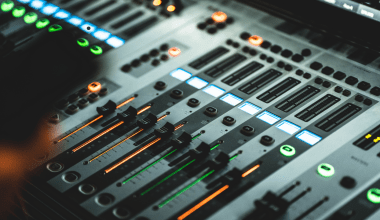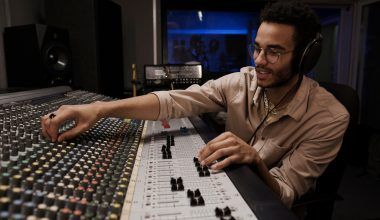If you’ve ever listened to music, watched a movie, or worked with audio recordings, you’ve probably come across the terms “mono” and “stereo.” These words describe how sound is recorded and played back. But what exactly is the difference between mono and stereo? And does it matter which one you choose?
In this guide, we’ll break down mono and stereo in simple terms. You’ll learn what they mean, how they work, and where they are best used. By the end, you’ll be able to choose the right option for your needs, whether it’s for music, podcasts, movies, or gaming.
What is Mono Audio?
Mono, short for “monophonic,” means that all sound is recorded and played back as a single channel. In simple words, all the audio is mixed together and comes from one source. Whether you’re listening with one speaker, two speakers, or headphones, the same sound is heard in both ears.
Key Features of Mono Audio:
- Single-channel sound: All sounds are combined into one.
- Same output everywhere: No matter how many speakers or headphones you use, the sound remains identical in each.
- Simpler to manage: It’s straightforward to record, mix, and play back.
Examples of Mono Audio in Use:
- Telephones: The sound you hear during calls is in mono.
- Podcasts: Most podcasts use mono to make voices clear and simple.
- PA Systems: Mono is common for public announcements to ensure the message is heard clearly.
Mono is great when clarity and consistency matter more than fancy effects or depth.
What is Stereo Audio?
Stereo, short for “stereophonic,” means the sound is split into two or more channels. Usually, you have a left and a right channel, which allows sound to come from different directions. This creates a sense of space, making you feel like you’re in the middle of the action.
Key Features of Stereo Audio:
- Multi-channel sound: Separate left and right channels create a sense of direction.
- Realistic and immersive: Mimics how we naturally hear sound in real life.
- Common in entertainment: Most music, movies, and video games use stereo for a richer experience.
Examples of Stereo Audio in Use:
- Music: Listen to a song in stereo, and you’ll notice instruments playing from different directions.
- Movies and TV Shows: Stereo makes the sound feel alive, like footsteps approaching from the left or a car passing on the right.
- Gaming: Stereo helps players hear where sounds are coming from, adding to the excitement.
Stereo is the go-to choice when you want audio to feel dynamic and lifelike.
How Mono and Stereo Work
Understanding the technical difference between mono and stereo can help you see why each has its strengths.
- Channels:
- Mono: One audio channel carries all the sound.
- Stereo: Two (or more) channels divide the sound.
- Sound Direction:
- Mono: Everything sounds like it’s coming from the same place.
- Stereo: Sounds can come from the left, right, or even move between the two.
- File Size:
- Mono files are smaller because they only have one audio track.
- Stereo files are larger since they store multiple tracks.
- Playback Compatibility:
- Mono works on any device or speaker.
- Stereo requires proper left and right speaker placement to fully enjoy the effect.
When to Use Mono
Mono is perfect when clarity, simplicity, and small file sizes are more important than creating an immersive sound experience.
Best Situations for Mono:
- Podcasts and Audiobooks: Keeps the voice clear and easy to understand.
- Public Speaking Events: Ensures everyone hears the same sound, no matter where they’re sitting.
- Old Recordings: Many classic songs and albums were recorded in mono.
Mono also saves storage space, making it ideal for smaller files or streaming where bandwidth is limited.
When to Use Stereo
Stereo is better when you want to make audio more engaging, dynamic, and realistic. It’s the industry standard for music and entertainment because it adds depth to the sound.
Best Situations for Stereo:
- Music Production: Stereo makes music feel alive, separating instruments and vocals for a richer experience.
- Movies and TV Shows: Creates a sense of being inside the action.
- Gaming: Directional sound adds excitement and helps players react faster.
Stereo is essential when sound needs to feel lifelike and interactive.
Pros and Cons of Mono
Pros:
- Simpler and easier to manage.
- Works on all devices and speakers.
- Smaller file sizes save storage space.
Cons:
- Feels flat and lacks depth.
- Not ideal for immersive experiences like music or movies.
Pros and Cons of Stereo
Pros:
- Adds realism and space to sound.
- Perfect for entertainment and creative projects.
- Enhances the listener’s experience.
Cons:
- Requires proper equipment to enjoy fully.
- Larger file sizes can take up more storage.
Mono vs Stereo in Music Production
Music producers often use both mono and stereo in their work.
- Mono in Mixing:
Producers check tracks in mono to ensure the music sounds good on all devices, even basic speakers. Vocals and bass are often recorded in mono for clarity. - Stereo in Final Production:
Stereo is used to add effects, depth, and width to the final mix. Instruments can be placed in different directions, giving the track a professional feel.
For selling music on platforms like Beatport, stereo is the standard because it provides a richer experience for listeners. However, checking mono compatibility ensures the music still sounds great on simpler devices.
How to Convert Between Mono and Stereo
If you have a mono track but need stereo, or vice versa, you can convert it using audio editing software like Audacity, Adobe Audition, or GarageBand.
- Converting Stereo to Mono:
Combine the left and right channels into one. Be cautious, as some details may be lost. - Converting Mono to Stereo:
Duplicate the mono track into two channels. Note that this won’t create true stereo depth unless you add effects.
Key Takeaways: Mono or Stereo?
- Use mono for simple, clear audio like podcasts or phone calls.
- Use stereo for rich, immersive sound like music, movies, or gaming.
The difference between mono and stereo isn’t just technical—it’s about creating the right listening experience for your audience.
Conclusion
Whether you’re a music producer, a podcaster, or just someone who loves great sound, knowing the difference between mono and stereo can help you make better decisions. Mono is simple, clear, and efficient, while stereo offers depth, direction, and realism.
By understanding their strengths and weaknesses, you’ll know exactly which format to use for your next project. And if you’re looking to sell your music on platforms like Beatport, stereo is the way to go for a professional, audience-friendly sound.
Related Articles:
For further reading, explore these related articles:
- What is Mono Audio: A Simple Guide to Mono Sound and Its Applications
- Understanding the Difference Between Performing Rights and Mechanical Rights
- The Vibrant Music Industry in Delhi: A Melting Pot of Talent and Opportunities
For additional resources on music marketing and distribution, visit Deliver My Tune.





